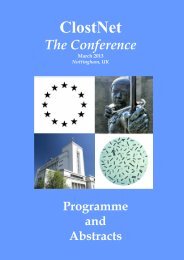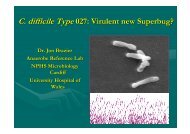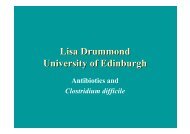abstract book - Clostridia
abstract book - Clostridia
abstract book - Clostridia
- No tags were found...
You also want an ePaper? Increase the reach of your titles
YUMPU automatically turns print PDFs into web optimized ePapers that Google loves.
BINDING OF EPSILON-TOXIN FROM CLOSTRIDIUM PERFRINGENS TOKIDNEYS AND NERVOUS SYSTEMJonatan Dorca-Arévalo 1 , Alex Soler-Jover 1 , Maryse Gibert 2 , Michel R.Popoff 2 , Mireia Martín-Satuéa 1 , Juan Blasi 11 Laboratori de Neurobiologia Cel·lular i Molecular, Dept de Patologia iTerapèutica Experimental, Campus de Bellvitge, Universitat de Barcelona-IDIBELL, c/Feixa Llarga s/n, 08907 L’Hospitalet de Llobregat, Spain2CNR Anaérobies, Institut Pasteur, 28 rue du Dr Roux, 75724 Paris, FranceEpsilon-toxin, produced by Clostridium perfringens type D, is the main agentresponsible for enterotoxaemia, in livestock. Neurological and renaldisorders are a characteristic of the onset of toxin poisoning.Recombinant epsilon-toxin-green fluorescence protein epsilon-toxin-GFP)and epsilon-prototoxin-GFP have already been characterized as useful toolsto track their distribution in intravenously injected mice (Soler-Jover, etal.,2004 J. Histochem. Cytochem.). Using a mouse model of acuteintoxication,we observed that epsilon-toxin-GFP, not only caused oedemabut also crossed the blood-brain barrier and accumulated into the braintissue. In some brain areas, epsilon-toxin-GFP bound to glial cells.Cytotoxicity assays with glial primary cultures, demonstrated the cytotoxiceffect of epsilon-toxin upon both astrocytes and microglial cells (Soler-Jover,et al., 2007 Toxicon). Here we attempt to identify specific acceptor moietiesand cell targets for epsilon-toxin in the mouse nervous system. Epsilontoxin-GFPfusion protein was used to incubate brain sections. Confocalmicroscopy analysis showed specific binding of epsilon-toxin to myelinicstructures. Protease treatments revealed that the binding was mainlyassociated to a proteinic component of the myelin.Myelinated peripheral nerve fibres were also stained by epsilon-toxin.Moreover, the binding to myelin was not only restricted to rodents, but wasalso found in humans, sheep and cattle. Curiously, in the brains of bothsheep and cattle, the toxin strongly stained the vascular endothelium.Although the binding of epsilon-toxin to myelin does not directly explain itsneurotoxic effect, this feature opens up a new line of enquiry into itsmechanism of toxicity and establishes the usefulness of this toxin for thestudy of the mammalian nervous system.Supported by MEC (BFU2005-02202) and ISCIII (PI040778 y PI050658).J.D-A is a recipient of a predoctoral fellowship from IDIBELL.
















